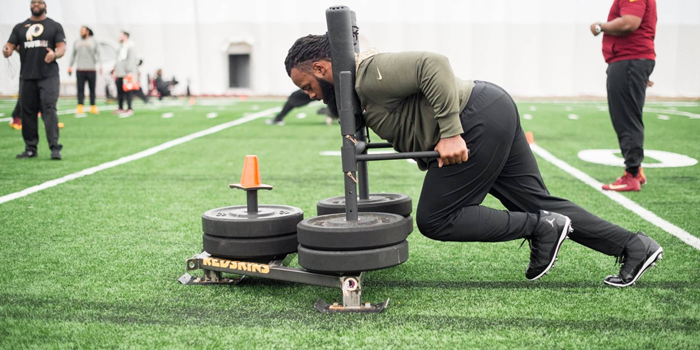What Is Conditioning In Sports
Conditioning in sports is an essential aspect that can make or break an athlete’s performance. It refers to the process of preparing the body and mind for the physical demands of a particular sport. Conditioning involves various exercises and drills that aim to improve an athlete’s strength, speed, endurance, agility, and overall fitness level.
In sports, conditioning is not only restricted to physical training but also involves mental preparation. Athletes need to be mentally tough to withstand the pressure and challenges that come with competing at a high level. This is why conditioning is crucial for athletes who want to excel in their chosen sport. In this article, we will delve deeper into the concept of conditioning in sports and explore its benefits in enhancing an athlete’s performance.

What is Conditioning in Sports?
Conditioning is a term that refers to the process of improving physical fitness and overall performance in sports. It is a crucial aspect of athletic training, and it involves a combination of different training techniques that are designed to enhance the body’s ability to perform at its best.
1. The Importance of Conditioning in Sports
Conditioning is essential for all athletes, regardless of their sport or level of competition. It helps to improve overall fitness, strength, and endurance, which are all essential for optimal performance. Conditioning also helps to prevent injuries and reduce the risk of developing chronic health conditions such as heart disease.
One of the main benefits of conditioning is that it helps athletes to perform at their best for longer periods. This is because it enhances the body’s ability to recover from physical exertion, which means that athletes can push themselves harder during training and competition. Additionally, conditioning helps to improve mental toughness, which is essential for success in sports.
To get the most out of conditioning, athletes should focus on a combination of different exercises and training techniques. These may include cardiovascular workouts, strength training, flexibility exercises, and skill-specific drills.
2. Cardiovascular Conditioning
Cardiovascular conditioning is an essential component of athletic training. It involves exercises that increase the heart rate and improve the body’s ability to transport oxygen to the muscles. Some examples of cardiovascular conditioning exercises include running, cycling, and swimming.
The benefits of cardiovascular conditioning include improved endurance, increased lung capacity, and a reduced risk of developing heart disease. It is important for athletes to engage in regular cardiovascular conditioning to maintain optimal health and performance.
3. Strength Training
Strength training is another important aspect of conditioning in sports. It involves exercises that are designed to improve muscle strength and power. Some examples of strength training exercises include weightlifting, plyometrics, and resistance band workouts.
The benefits of strength training include improved muscle mass, increased bone density, and a reduced risk of injury. It is important for athletes to engage in regular strength training to maintain a strong and healthy body.
4. Flexibility Exercises
Flexibility exercises are also an essential component of conditioning in sports. They involve stretching and other exercises that are designed to improve range of motion and flexibility. Some examples of flexibility exercises include yoga, Pilates, and dynamic stretching.
The benefits of flexibility exercises include improved joint mobility, reduced risk of injury, and improved athletic performance. It is important for athletes to engage in regular flexibility exercises to maintain optimal health and performance.
5. Skill-Specific Drills
Skill-specific drills are exercises that are designed to improve specific skills related to a particular sport. For example, basketball players might engage in dribbling drills, while swimmers might practice their strokes. Skill-specific drills help athletes to develop the skills they need to perform at their best during competition.
The benefits of skill-specific drills include improved technique, increased confidence, and improved overall performance. It is important for athletes to engage in regular skill-specific drills to maintain a competitive edge.
6. High-Intensity Interval Training (HIIT)
High-intensity interval training (HIIT) is a type of cardiovascular conditioning that involves short, intense bursts of activity followed by periods of rest. HIIT is an effective way to improve cardiovascular fitness and burn fat.
The benefits of HIIT include improved endurance, increased metabolism, and improved overall fitness. It is important for athletes to engage in regular HIIT workouts to maintain optimal health and performance.
7. Cross-Training
Cross-training is a type of training that involves engaging in multiple sports or activities. For example, a runner might also swim or cycle to improve overall fitness and prevent injury. Cross-training is an effective way to improve overall fitness and prevent burnout.
The benefits of cross-training include improved overall fitness, reduced risk of injury, and increased motivation. It is important for athletes to engage in regular cross-training to maintain a well-rounded and healthy body.
8. Benefits of Conditioning
The benefits of conditioning are numerous and include improved overall fitness, increased strength and endurance, reduced risk of injury, and improved mental toughness. Conditioning is essential for all athletes, regardless of their sport or level of competition.
By engaging in regular conditioning workouts, athletes can improve their performance and maintain optimal health. Conditioning is a crucial aspect of athletic training that should not be overlooked.
9. Conditioning vs. Training
While conditioning and training are often used interchangeably, they are not the same thing. Conditioning refers specifically to the process of improving physical fitness and overall performance, while training refers to the process of developing specific skills related to a particular sport.
While both conditioning and training are essential for athletic success, it is important to understand the difference between the two. By engaging in both conditioning and training, athletes can develop the skills they need to perform at their best during competition.
10. Conclusion
Conditioning is a crucial aspect of athletic training that is essential for all athletes. By engaging in regular conditioning workouts, athletes can improve their overall fitness, strength, and endurance, reduce their risk of injury, and develop the mental toughness they need to succeed in their sport.
Whether you are a professional athlete or a weekend warrior, conditioning should be an essential part of your training routine. By focusing on a combination of cardiovascular conditioning, strength training, flexibility exercises, skill-specific drills, and other training techniques, you can improve your performance and achieve your athletic goals.
Frequently Asked Questions
Conditioning in sports is a term used to describe the process of preparing an athlete’s body to perform at its best. This includes training the body to handle the physical demands of the sport, building stamina, and improving overall health and fitness.
What is sports conditioning?
Sports conditioning is a training method that is used to improve an athlete’s physical abilities and prepare them for competition. This includes exercises that focus on improving strength, endurance, agility, speed, and flexibility. Sports conditioning can also help prevent injuries by strengthening the muscles and joints and improving balance and coordination.
Conditioning programs are designed to be specific to the sport and position of the athlete. For example, a basketball player may focus on developing explosive jumping power and quick lateral movement, while a football player may focus on improving upper body strength and tackling technique.
Why is conditioning important in sports?
Conditioning is important in sports because it can help improve an athlete’s performance and reduce the risk of injury. A well-designed conditioning program can help an athlete build strength, endurance, and agility, which can improve their overall athleticism and ability to perform in their sport.
Conditioning can also help prevent injuries by strengthening the muscles and joints and improving flexibility and balance. Athletes who are in good physical condition are less likely to suffer from injuries such as strains, sprains, and fractures.
What are some examples of conditioning exercises?
There are a variety of conditioning exercises that can be used to improve an athlete’s physical abilities. These include exercises that focus on improving strength, endurance, agility, speed, and flexibility. Examples of conditioning exercises include weightlifting, running, jumping, plyometrics, agility drills, and stretching.
The specific exercises used in a conditioning program will depend on the sport and position of the athlete, as well as their individual strengths and weaknesses. A conditioning program should be designed to address the specific needs of the athlete and help them achieve their performance goals.
How often should an athlete do conditioning exercises?
The frequency of conditioning exercises will depend on the athlete’s goals and current level of fitness. In general, athletes should aim to do conditioning exercises at least three to four times per week.
However, the frequency and intensity of conditioning exercises should be gradually increased over time to prevent injury and allow the body to adapt to the demands of training. Athletes should also incorporate rest and recovery into their conditioning program to allow the body to repair and regenerate between workouts.
How long does it take to see results from conditioning exercises?
The time it takes to see results from conditioning exercises will depend on the athlete’s goals and their current level of fitness. In general, athletes can expect to see improvements in their physical abilities within a few weeks to a few months of starting a conditioning program.
However, it is important to remember that conditioning is a long-term process that requires consistent effort and dedication. Athletes should be patient and stay committed to their conditioning program in order to achieve their performance goals.
Conditioning Workouts And Exercises Explained
Conditioning in sports is an essential aspect that plays a significant role in achieving optimal performance. It involves the process of training and preparing athletes to perform at their best level while reducing the risk of injuries. Conditioning programs are designed to enhance an athlete’s physical, mental, and emotional abilities, allowing them to perform at their peak during games and competitions.
To achieve the desired results, conditioning programs involve a combination of strength training, cardiovascular exercises, and agility drills. These programs are tailored to meet the specific needs of individual athletes and are regularly updated to keep up with their progress. By incorporating conditioning into their training regimen, athletes can improve their stamina, endurance, and speed, giving them a competitive edge over their opponents. Ultimately, conditioning is a vital component in sports, and it is not only beneficial to athletes but also to the team as a whole.



